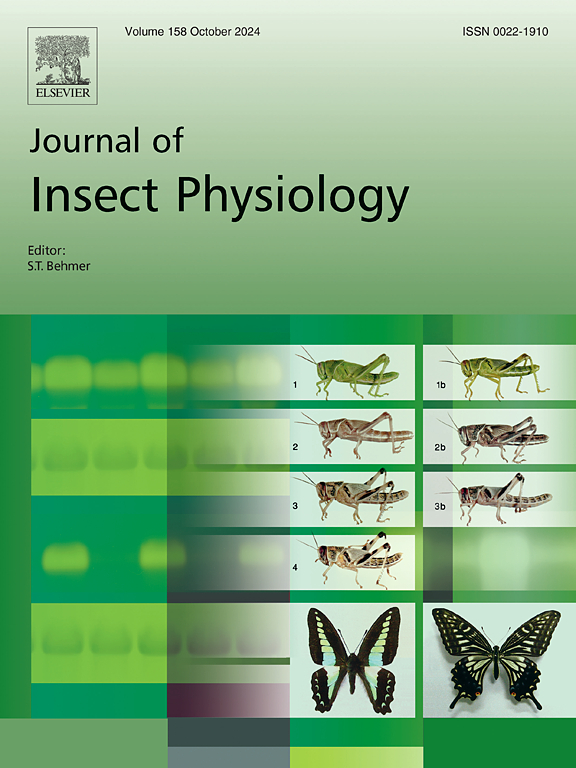发育时间综合了温度和寄主植物对三种热带斑蝶眼斑大小的影响
IF 2.3
2区 农林科学
Q1 ENTOMOLOGY
引用次数: 0
摘要
许多热带蝴蝶有明显的湿季和干季成虫,翅膀上眼斑的大小不同。幼虫发育过程中所处的环境影响了眼斑的大小,这种可塑性是适应性的,因为幼虫在各自的季节有较高的存活率。许多品种的幼虫期温度较高,成虫的眼斑较大。这种反应规范在雨季之前的高温下是适应性的,但并非所有地区都是如此。因此,蝴蝶可能依赖于其他环境线索,如寄主植物物种,也可能通过多种环境变量对幼虫发育时间的综合影响来整合信息。为了验证这一点,我们利用温度和寄主植物种类的组合,操纵了三种同域种群的发育时间——绿斑蝶(Ypthima huebneri)、绿斑蝶(Mycalesis mineus)和黑斑蝶(Melanitis leda)。饲养温度越高,眼斑大小越大。寄主植物种类独立影响眼斑大小。温度和寄主植物的影响在物种、性别、前翅和后翅之间存在差异,表明眼点的选择压力存在差异。然而,温度和寄主植物种类的信息可能通过发育时间整合,因为幼虫发育时间越短,成虫眼斑越大。然而,在特定的处理、物种和眼点中也有例外。我们的研究结果强调了眼斑大小的复杂控制,这可能受到一系列相互作用因素的影响。我们的研究还表明,不同物种的同域种群如何以不同的方式解释相似的环境线索。本文章由计算机程序翻译,如有差异,请以英文原文为准。

Development time integrates temperature and host plant cues for eyespot size in three tropical satyrine butterflies
Many tropical butterflies have distinct wet and dry season adult morphs differing in the size of wing eyespots. Eyespot size is influenced by the environment experienced by developing larvae, and this plasticity is adaptive because the morphs have higher survival in their respective seasons. Higher temperature during the larval phase produces adults with larger eyespots in many species. This reaction norm is adaptive when high temperatures precede the wet season, which is not the case in all regions. Therefore, butterflies may rely on another environmental cue such as host plant species, and may also integrate information from multiple environmental variables through their combined effect on larval developmental time. To test this, we manipulated developmental time of sympatric populations of three butterflies − Ypthima huebneri, Mycalesis mineus and Melanitis leda − using combinations of temperatures and host plant species. Higher rearing temperature correlated with larger eyespot size in all species. Host plant species independently affected eyespot size. The effects of temperature and host plant differed between species, sexes, and between the forewing and hindwing, suggesting differential selection pressures on eyespots. Nevertheless, information about temperature and host plant species may be integrated through developmental time, because shorter larval development time was correlated with larger eyespots in adults. However, there were exceptions within specific treatments, species, and eyespots. Our results highlight the complex control of eyespot size, which is likely influenced by a network of interacting factors. Our study also demonstrates how sympatric populations of different species interpret similar environmental cues differently.
求助全文
通过发布文献求助,成功后即可免费获取论文全文。
去求助
来源期刊

Journal of insect physiology
生物-昆虫学
CiteScore
4.50
自引率
4.50%
发文量
77
审稿时长
57 days
期刊介绍:
All aspects of insect physiology are published in this journal which will also accept papers on the physiology of other arthropods, if the referees consider the work to be of general interest. The coverage includes endocrinology (in relation to moulting, reproduction and metabolism), pheromones, neurobiology (cellular, integrative and developmental), physiological pharmacology, nutrition (food selection, digestion and absorption), homeostasis, excretion, reproduction and behaviour. Papers covering functional genomics and molecular approaches to physiological problems will also be included. Communications on structure and applied entomology can be published if the subject matter has an explicit bearing on the physiology of arthropods. Review articles and novel method papers are also welcomed.
 求助内容:
求助内容: 应助结果提醒方式:
应助结果提醒方式:


